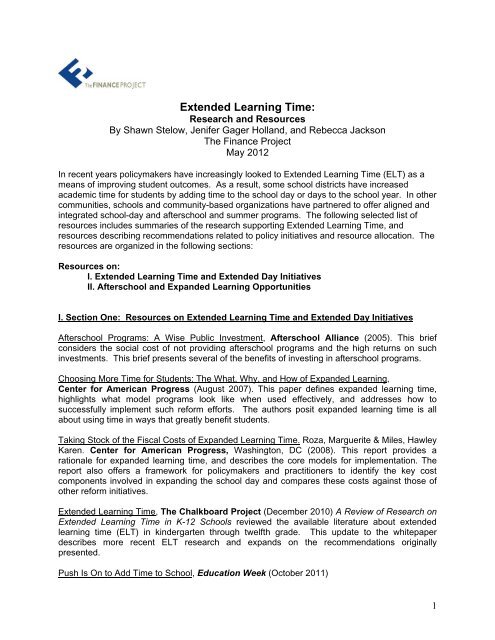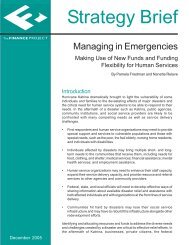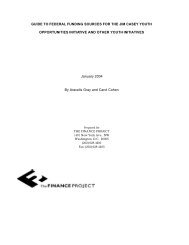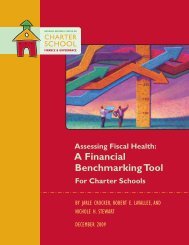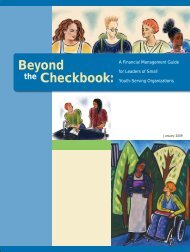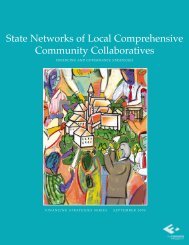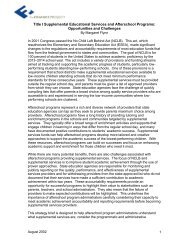Extended Learning Time: Research and Resources - The Finance ...
Extended Learning Time: Research and Resources - The Finance ...
Extended Learning Time: Research and Resources - The Finance ...
You also want an ePaper? Increase the reach of your titles
YUMPU automatically turns print PDFs into web optimized ePapers that Google loves.
<strong>Extended</strong> <strong>Learning</strong> <strong>Time</strong>:<br />
<strong>Research</strong> <strong>and</strong> <strong>Resources</strong><br />
By Shawn Stelow, Jenifer Gager Holl<strong>and</strong>, <strong>and</strong> Rebecca Jackson<br />
<strong>The</strong> <strong>Finance</strong> Project<br />
May 2012<br />
In recent years policymakers have increasingly looked to <strong>Extended</strong> <strong>Learning</strong> <strong>Time</strong> (ELT) as a<br />
means of improving student outcomes. As a result, some school districts have increased<br />
academic time for students by adding time to the school day or days to the school year. In other<br />
communities, schools <strong>and</strong> community-based organizations have partnered to offer aligned <strong>and</strong><br />
integrated school-day <strong>and</strong> afterschool <strong>and</strong> summer programs. <strong>The</strong> following selected list of<br />
resources includes summaries of the research supporting <strong>Extended</strong> <strong>Learning</strong> <strong>Time</strong>, <strong>and</strong><br />
resources describing recommendations related to policy initiatives <strong>and</strong> resource allocation. <strong>The</strong><br />
resources are organized in the following sections:<br />
<strong>Resources</strong> on:<br />
I. <strong>Extended</strong> <strong>Learning</strong> <strong>Time</strong> <strong>and</strong> <strong>Extended</strong> Day Initiatives<br />
II. Afterschool <strong>and</strong> Exp<strong>and</strong>ed <strong>Learning</strong> Opportunities<br />
I. Section One: <strong>Resources</strong> on <strong>Extended</strong> <strong>Learning</strong> <strong>Time</strong> <strong>and</strong> <strong>Extended</strong> Day Initiatives<br />
Afterschool Programs: A Wise Public Investment, Afterschool Alliance (2005). This brief<br />
considers the social cost of not providing afterschool programs <strong>and</strong> the high returns on such<br />
investments. This brief presents several of the benefits of investing in afterschool programs.<br />
Choosing More <strong>Time</strong> for Students: <strong>The</strong> What, Why, <strong>and</strong> How of Exp<strong>and</strong>ed <strong>Learning</strong>,<br />
Center for American Progress (August 2007). This paper defines exp<strong>and</strong>ed learning time,<br />
highlights what model programs look like when used effectively, <strong>and</strong> addresses how to<br />
successfully implement such reform efforts. <strong>The</strong> authors posit exp<strong>and</strong>ed learning time is all<br />
about using time in ways that greatly benefit students.<br />
Taking Stock of the Fiscal Costs of Exp<strong>and</strong>ed <strong>Learning</strong> <strong>Time</strong>. Roza, Marguerite & Miles, Hawley<br />
Karen. Center for American Progress, Washington, DC (2008). This report provides a<br />
rationale for exp<strong>and</strong>ed learning time, <strong>and</strong> describes the core models for implementation. <strong>The</strong><br />
report also offers a framework for policymakers <strong>and</strong> practitioners to identify the key cost<br />
components involved in exp<strong>and</strong>ing the school day <strong>and</strong> compares these costs against those of<br />
other reform initiatives.<br />
<strong>Extended</strong> <strong>Learning</strong> <strong>Time</strong>, <strong>The</strong> Chalkboard Project (December 2010) A Review of <strong>Research</strong> on<br />
<strong>Extended</strong> <strong>Learning</strong> <strong>Time</strong> in K-12 Schools reviewed the available literature about extended<br />
learning time (ELT) in kindergarten through twelfth grade. This update to the whitepaper<br />
describes more recent ELT research <strong>and</strong> exp<strong>and</strong>s on the recommendations originally<br />
presented.<br />
Push Is On to Add <strong>Time</strong> to School, Education Week (October 2011)<br />
1
This article examines a new 7th-period class, which adds an extra hour to the school day, five<br />
days a week for 6 th graders in Providence, RI. <strong>The</strong> extra hour focused on building student<br />
competency <strong>and</strong> a deeper underst<strong>and</strong>ing of the STEM (science, technology, engineering, <strong>and</strong><br />
math) subjects. For two of those weekly periods, the students venture outside the walls of Roger<br />
Williams Middle School for field-based learning experiences led by their teacher in conjunction<br />
with community providers.<br />
Supporting Student Outcomes Through Exp<strong>and</strong>ed <strong>Learning</strong> Opportunities, Harvard Family<br />
<strong>Research</strong> Project (2009) Priscilla M. Little. <strong>Research</strong> Report. This paper looks at the role of<br />
after school <strong>and</strong> summer learning programs in supporting student success. <strong>The</strong> paper explores<br />
how to bridge the divide between out-of-school time programs <strong>and</strong> schools by offering researchderived<br />
principles for effective exp<strong>and</strong>ed learning partnerships. It was commissioned by<br />
<strong>Learning</strong> Point Associates <strong>and</strong> the Collaborative for Building After-School Systems (CBASS) as<br />
part of a report on school reform <strong>and</strong> exp<strong>and</strong>ed learning.<br />
Massachusetts 2020 is an organization dedicated to exp<strong>and</strong>ing learning time to improve<br />
student achievement. Massachusetts 2020’s Exp<strong>and</strong>ed <strong>Learning</strong> <strong>Time</strong> (ELT) Initiative in<br />
Massachusetts is redesigning schools to offer children new learning <strong>and</strong> enrichment<br />
opportunities made possible because of an exp<strong>and</strong>ed school schedule. <strong>The</strong> following four<br />
resources describe aspects <strong>and</strong> effects of the ELT Initiative:<br />
• Executive Summary: Year 1 of the Exp<strong>and</strong>ed <strong>Learning</strong> <strong>Time</strong> Initiative 2006-2007<br />
• Complete Report: Year 1 of the Exp<strong>and</strong>ed <strong>Learning</strong> <strong>Time</strong> Initiative<br />
• <strong>The</strong> Effects of Extending <strong>Learning</strong> <strong>Time</strong> in Real-World, Classroom Settings<br />
This is a short report that synthesizes examples of research studies that explore the<br />
relationship between time <strong>and</strong> learning in a real-world, classroom setting.<br />
• <strong>The</strong> Effects of Longer Class Periods<br />
A short report that summarizes three studies of the effects of block scheduling.<br />
<strong>Time</strong> for <strong>Learning</strong>: Education Policy White Paper, National Academy for Education<br />
This paper provides recommendations concerning federal policy initiatives. <strong>The</strong><br />
recommendations are intended to stimulate <strong>and</strong> support efforts by state <strong>and</strong> local<br />
Governments, business interests, <strong>and</strong> philanthropies to extend in-school <strong>and</strong> out-of-school<br />
learning opportunities for students from kindergarten through grade 12.<br />
<strong>The</strong> Washington State Institute for Public Policy was asked by legislative staff to estimate<br />
the economic value of learning time.<br />
Improving student achievement by extending school: Is it just a matter of time? Aronson, J.<br />
Zimmerman, J. <strong>and</strong> Carlos, L. (1999). San Francisco: WestEd. This study uses the Academic<br />
<strong>Learning</strong> <strong>Time</strong> (ALT) model to analyze proposals to extend the school calendar. Authors explain<br />
that the first task for schools is to maximize ALT within the existing school day before adding<br />
additional time.<br />
<strong>The</strong> National Center on <strong>Time</strong> & <strong>Learning</strong> has compiled this unique database of U.S. public<br />
schools that operate with more time per day <strong>and</strong>/or more days per year compared to<br />
surrounding public schools, for all enrolled students.<br />
2
It’s being done: Academic success in unexpected schools. Chenoweth, K. (2007).<br />
Cambridge, MA: Harvard Education Press. <strong>The</strong> author examines a variety of schools where<br />
students outperform their socioeconomically-matched peers. <strong>The</strong> author identifies setting high<br />
expectations for students, data-driven instruction, the thoughtful use of school time, ongoing<br />
professional development for teachers, <strong>and</strong> competent leadership teams as key tenets of these<br />
effective schools.<br />
<strong>The</strong> Strategic School: How to make the most of people, time <strong>and</strong> money. Miles, K.H. <strong>and</strong><br />
Frank, S. San Francisco: Corwin Press (2008). In this textbook, the authors explore how<br />
educational leaders can develop successful <strong>and</strong> strategic schools by assessing how well they<br />
use all available resources—people, time, <strong>and</strong> money – <strong>and</strong> stress, in particular, that increasing<br />
instructional time within the confines of the school day is paramount.<br />
II. Section Two: <strong>Resources</strong> on Afterschool <strong>and</strong> Exp<strong>and</strong>ed <strong>Learning</strong> Opportunities<br />
<strong>The</strong> Afterschool Alliance<br />
• Afterschool Benefits Kids with Special Needs (2008).<br />
This brief highlights the effectiveness of afterschool programming by offering children<br />
with special needs an opportunity to develop alongside their non-disabled peers. <strong>The</strong><br />
benefits of afterschool for kids with special needs include improved performance on<br />
st<strong>and</strong>ardized tests, mastery of individualized education goals, higher grades, improved<br />
behavior <strong>and</strong> increased motivation to learn.<br />
• Afterschool Fosters Success in School (2008).<br />
This brief explores the various ways afterschool programs support student achievement.<br />
It is one in a series of Issue Briefs sponsored by the MetLife Foundation that addresses<br />
the benefits afterschool programs provide to children, families <strong>and</strong> communities.<br />
• Afterschool Innovations in Brief (2008).<br />
With support from MetLife Foundation, the Afterschool Alliance published a compilation<br />
of four issue briefs examining critical issues facing children, schools <strong>and</strong> communities,<br />
<strong>and</strong> the vital role afterschool programs play in addressing these issues.<br />
• Afterschool: A Powerful Path to Teacher Recruitment <strong>and</strong> Retention (2007).<br />
This brief examines the current teacher shortage facing our schools, the impact this<br />
shortage is having on our rapidly changing educational system, <strong>and</strong> ways afterschool<br />
programs can help meet the need for recruiting <strong>and</strong> retaining new teachers. It is one in<br />
a series of Issue Briefs sponsored by the MetLife Foundation that addresses the benefits<br />
afterschool programs provide to children, families, <strong>and</strong> communities.<br />
• Afterschool: Providing a Successful Route to Credit Attainment <strong>and</strong> Recovery (2009).<br />
Afterschool provides older youth with critical academic supports including credit<br />
attainment <strong>and</strong> recovery opportunities. Many educators are turning to afterschool<br />
programs to reach students who fail one or more courses, become disengaged, or want<br />
alternatives to the traditional path to graduation.<br />
• Afterschool: Supporting Career <strong>and</strong> College Pathways for Middle School Age Youth<br />
(2011). Afterschool programs offer a key opportunity to expose students to higher<br />
3
education options <strong>and</strong> career paths <strong>and</strong> teach them skills that can unlock doors to future<br />
career prospects. During the afterschool hours there is time for apprenticeships, guest<br />
speakers <strong>and</strong> project based activities that are not always available during a school day<br />
filled with the core curriculum. This MetLife Issue Brief focuses on the need to better<br />
prepare youth for high school, college, <strong>and</strong> careers, while keeping them on track <strong>and</strong><br />
engaged in middle school.<br />
• Afterschool <strong>and</strong> Working Families in Wake of the Great Recession (2011).<br />
<strong>The</strong> Great Recession has had dramatic effects on the availability <strong>and</strong> affordability of<br />
afterschool programs, the accessibility of employment <strong>and</strong> childcare options for parents<br />
<strong>and</strong>, most of all, the education <strong>and</strong> future of our nation’s youth. This brief examines the<br />
ways in which afterschool programs coped with the economic downturn <strong>and</strong> its effects<br />
on children, families <strong>and</strong> communities.<br />
• English Language Learners: Becoming Fluent in Afterschool (2011).<br />
English Language Learners (ELLs), a diverse group of individuals from across the world<br />
who are learning English for the first time, make up the fastest growing segment of the<br />
student population in United States public schools. This issue brief displays how the<br />
extra time <strong>and</strong> h<strong>and</strong>s-on learning experiences provided by quality afterschool programs<br />
can allow for a specialized, less-formal learning environment in which ELLs can develop<br />
language <strong>and</strong> social skills that otherwise could not be addressed through the less<br />
flexible schedule of the regular school day.<br />
• Quality Afterschool: Helping Programs Achieve It <strong>and</strong> Policies Support It (2011).<br />
For years, policy makers, program directors <strong>and</strong> parents have attested to the<br />
widespread benefits of afterschool programs. Fortunately, a wide variety of research<br />
ranging from quantitative studies <strong>and</strong> polls to qualitative reports <strong>and</strong> field observations<br />
has corroborated the need for afterschool enrichment. Promoting quality in the field of<br />
afterschool, which includes before school <strong>and</strong> summer learning programs, is one way to<br />
ensure researchers continue to find positive outcomes that can convince policy makers<br />
to increase investments in this valuable resource to children <strong>and</strong> parents.<br />
• Roadmap to Afterschool for All (2009).<br />
With support from the Harvard School of Public Health <strong>and</strong> the Charles Stewart Mott<br />
Foundation <strong>and</strong> the Atlantic Philanthropies, the Afterschool Alliance initiated the<br />
Roadmap to Afterschool for All, a scientific study that assesses the current investment in<br />
afterschool programs from the public sector, parents, foundations, <strong>and</strong> businesses, <strong>and</strong><br />
estimates the additional investment needed from each sector to provide quality<br />
afterschool programs for all children. <strong>The</strong> research shows that parents are paying the<br />
majority of afterschool costs, even among programs serving high poverty children, <strong>and</strong><br />
that funding of all types is insufficient.<br />
Child Trends<br />
• How Out-of-School <strong>Time</strong> Program Quality is related to adolescent Outcomes (2010).<br />
Kristin Anderson Moore, Ph.D. <strong>and</strong> Kathleen Hamilton, M.A. This brief examines the<br />
hypothesis that adolescents in high-quality <strong>and</strong> safe programs tend to engage in fewer<br />
risky behaviors, to have greater social competency, <strong>and</strong> to have better school<br />
performance than adolescents not in a program. <strong>Research</strong> has identified elements of<br />
program quality that support three positive adolescent outcomes—(1) youth in forming<br />
4
positive relationships, (2) making decisions, <strong>and</strong> (3) encouraging learning. In addition,<br />
safety—or fostering a safe physical <strong>and</strong> emotional environment—is often identified as a<br />
key element in program quality.<br />
• Practices to Avoid in Out-of-School <strong>Time</strong> Programs (2010). Kristin Anderson Moore,<br />
Ph.D., Ashleigh Collins, M.A., <strong>and</strong> Jacinta Bronte-Tinkew, Ph.D. This brief highlights<br />
lessons about specific program practices that should be avoided or minimized in out-ofschool<br />
time programs to improve student success.<br />
• Practices to Foster in Out-of-School <strong>Time</strong> Programs (2010). Kristin Anderson Moore,<br />
Ph.D., Jacinta Bronte-Tinkew, Ph.D., <strong>and</strong> Ashleigh Collins, M.A. This brief draws from<br />
research <strong>and</strong> a series of Roundtable discussions with practitioners <strong>and</strong> youth, to identify<br />
10 practices that can foster positive outcomes for participants in out-of-school time<br />
programs.<br />
<strong>The</strong> Forum for Youth Investment<br />
• Out-of-School <strong>Time</strong> Policy Commentary #15: Raising the Bar: Quality Improvement<br />
Systems for Youth Programs (2009). This commentary compiles lessons learned about<br />
building quality improvement systems for OST programs, based on emerging research<br />
<strong>and</strong> increasing activity in the field. <strong>The</strong> commentary also takes readers to the state of<br />
Michigan <strong>and</strong> the city of Chicago, where implementation of this model is underway with<br />
promising results.<br />
• Out of School <strong>Time</strong> Policy Commentary #14: "After School Grows Up: Helping Teens<br />
Prepare for the Future” (2009). This commentary describes innovations in Afterschool<br />
Programs in northern <strong>and</strong> southern California, Chicago, New York, <strong>and</strong> New Hampshire.<br />
<strong>The</strong> William T. Grant Foundation<br />
• After-School Programs <strong>and</strong> Academics: Implications for Policy, Practice, <strong>and</strong> <strong>Research</strong><br />
(2008). <strong>The</strong> increasing emphasis on academics <strong>and</strong> supporting learning in afterschool<br />
<strong>and</strong> youth development programs has lead to predictable tensions over time, structure,<br />
<strong>and</strong> resources. This report focuses on the growing program-evaluation literature,<br />
observational studies, <strong>and</strong> commentaries <strong>and</strong> statements of program st<strong>and</strong>ards by<br />
practitioners <strong>and</strong> advocates in the context of this debate.<br />
Harvard Family <strong>Research</strong> Project<br />
• Evaluation of 21st Century Community <strong>Learning</strong> Center Programs: A Guide for State<br />
Education Agencies (2002). Priscilla M. D. Little, Flora Traub, Karen Horsch (April 2002)<br />
<strong>Research</strong> Report. This brief offers an in-depth look at the 21st Century Community<br />
<strong>Learning</strong> Center (21st CCLC) evaluation requirements (performance measurement <strong>and</strong><br />
program evaluation) <strong>and</strong> provides practical suggestions about how to implement 21st<br />
CCLC evaluation at the state <strong>and</strong> local level. It includes a checklist of issues to consider<br />
when designing state <strong>and</strong> local 21st CCLC evaluations.<br />
• Exp<strong>and</strong>ed <strong>Learning</strong> Opportunities in New Jersey—Pathways to Student Success (2010).<br />
Little, Priscilla M. <strong>Research</strong> Report. This Exp<strong>and</strong>ed <strong>Learning</strong> Opportunities (ELO) policy<br />
brief, prepared for New Jersey After 3’s Exp<strong>and</strong>ed <strong>Learning</strong> <strong>Time</strong> Summit in September<br />
5
2010, describes the potential benefits of participation in a range of well-implemented<br />
ELO programs <strong>and</strong> initiatives for students of all ages, including afterschool <strong>and</strong> summer<br />
programming, <strong>and</strong> underscores the benefits of strong partnerships for learning between<br />
schools <strong>and</strong> out-of-school learning supports. It concludes with a set of key policy factors<br />
to consider when adopting different ELO approaches.<br />
• Federal Funding in Out-of School <strong>Time</strong> With Accountability Requirements <strong>and</strong><br />
Evaluations (2000). <strong>The</strong>se Web documents were produced by HFRP as part of its initial<br />
efforts to “map” the out-of-school time field, <strong>and</strong> detail federal funding streams for out-ofschool<br />
time programs <strong>and</strong> related programming alongside their accountability<br />
requirements <strong>and</strong> evaluations. A summary section offers a narrative description of each<br />
funding stream. <strong>The</strong> funding streams are classified as major or minor depending on the<br />
amount of money available for out-of-school time efforts.<br />
• <strong>The</strong> Federal Role in Out-of-School <strong>Learning</strong>: After-School, Summer <strong>Learning</strong>, <strong>and</strong><br />
Family Involvement as Critical <strong>Learning</strong> Supports (Voices in Urban Education, Summer<br />
2009). Heather B. Weiss, Priscilla M.D. Little, Suzanne M. Bouffard, Sarah N.<br />
Deschenes, Helen Janc Malone. This article uses research-based evidence to make the<br />
case for the federal provision of out-of-school complementary learning supports.<br />
• Strengthen What Happens Outside School to Improve What Happens Inside (2009).<br />
Heather Weiss, Priscilla Little, Suzanne M. Bouffard, Sarah N. Deschenes, Helen Janc<br />
Malone (April 2009) <strong>Research</strong> Report. This article offers research-based<br />
recommendations for federal education legislation that highlight the importance of out-ofschool<br />
learning as complementary to school improvement strategies. <strong>The</strong><br />
recommendations challenge the long-st<strong>and</strong>ing assumption underlying federal education<br />
legislation, namely that that K-12 schools can operate alone to level the learning field for<br />
poor children.<br />
• Year-Round <strong>Learning</strong>: Linking School, Afterschool, <strong>and</strong> Summer <strong>Learning</strong> to Support<br />
Student Success (2011). Deschenes, Sarah & Malone, Helen Janc (June 2011)<br />
<strong>Research</strong> Report. <strong>The</strong>re is growing national discussion about the need to create a more<br />
expansive definition of learning to include all the ways that youth can access educational<br />
opportunities—not just through the traditional school model, but also through afterschool<br />
activities, time spent with the family, <strong>and</strong> through interaction with digital media. This brief<br />
analyzes one approach to exp<strong>and</strong>ed learning that provides high-needs students with<br />
access to quality learning environments across the year.<br />
National Conference of State Legislatures <strong>and</strong> Harvard Family <strong>Research</strong> Project Series<br />
• ELO <strong>Research</strong>, Policy, <strong>and</strong> Practice No. 1: Helping Older Youth Succeed Through<br />
Exp<strong>and</strong>ed <strong>Learning</strong> Opportunities (2011). Harris, Erin, Deschenes, Sarah, & Wallace,<br />
Ashley (August 2011) <strong>Research</strong> Report. This brief examines the benefits of ELOs for<br />
older youth as well as the policy implications of recent research. In addition, the brief<br />
provides examples of positive youth outcomes, common characteristics of high quality<br />
programs <strong>and</strong> initiatives, <strong>and</strong> policy recommendations.<br />
National League of Cities<br />
6
• Strategy Guide: Collecting <strong>and</strong> Using Information to Strengthen Citywide Out-of-School<br />
<strong>Time</strong> Systems (2011). Russell, Lane & Little, Priscilla. Cities around the country are<br />
building systems that seek to make the most of public <strong>and</strong> private resources to provide<br />
widespread, high-quality, out-of-school time (OST) opportunities. Participation in OST<br />
programs not only benefits young people <strong>and</strong> the cities in which they live with the<br />
potential to help reduce crime <strong>and</strong> create a more skilled workforce. This guide provides<br />
municipal leaders <strong>and</strong> their key partners with strategies for collecting <strong>and</strong> using<br />
information to strengthen citywide OST systems.<br />
TASC <strong>and</strong> the Partnership for Children <strong>and</strong> Youth<br />
• <strong>Time</strong> for Congress to St<strong>and</strong> up for Exp<strong>and</strong>ed <strong>Learning</strong> (2011). Originally published in<br />
the Huffington Post, this essay makes the case for strengthening <strong>and</strong> exp<strong>and</strong>ing the 21st<br />
Century Community <strong>Learning</strong> Centers (21st CCLC) program.<br />
<strong>The</strong> Wallace Foundation<br />
• Fiscal Fitness for Nonprofits: Project Puts Chicago After-School Programs <strong>and</strong> Funders<br />
Through a Financial Workout (2011). This report describes the foundation’s effort to<br />
strengthen financial management at high-performing nonprofits that run after-school<br />
programs.<br />
• Strengthening out-of-school time nonprofits: <strong>The</strong> role of foundations in building<br />
organizational capacity (2008). Weiss, Heather B. A discussion of seven organizational<br />
challenges facing the nonprofit out-of-school time (OST) sector, with recommendations<br />
for improving the organizational capacities of OST nonprofit sector.<br />
7


